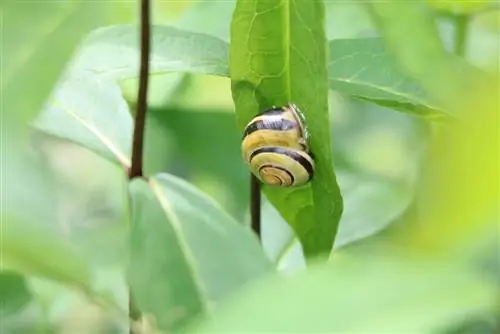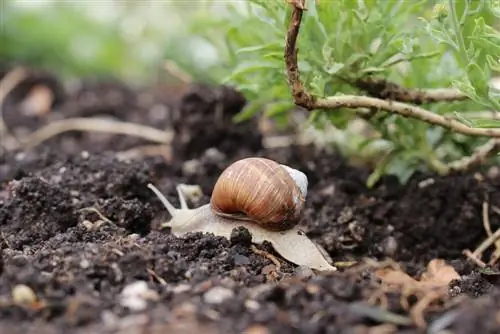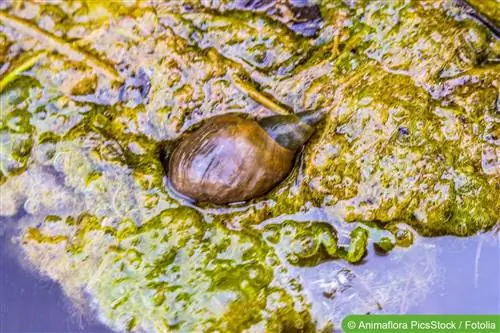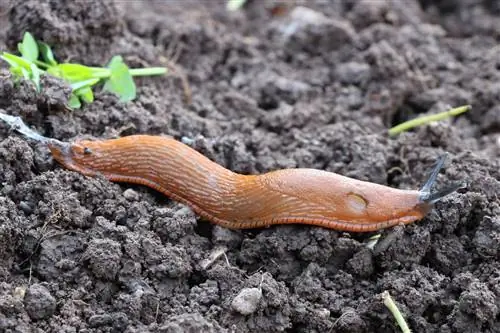- Author admin [email protected].
- Public 2023-12-17 03:39.
- Last modified 2025-01-24 12:45.
On the plate, snails delight discerning gourmets, while snails in particular are not welcome in the garden. Nevertheless, all species contribute positively to the ecosystem. They don't like the cold, but they can't escape winter in Western Europe. This is how nature has given them bodily functions that enable them to survive the frosty season. They instinctively look for a suitable place to overwinter where their body systems slow down when the winter temperatures are appropriate. Below you will find out what the different snails do in winter.
Wintering
When winter is just around the corner, the numerous species of snails react in many different ways. While many species of slugs die in autumn but still lay their eggs to overwinter, others look for a protected place where the frost cannot reach them. Wintering usually begins in mid/late October and ends as soon as temperatures rise again, which is usually the end of March/beginning of April. Then they crawl out of their hiding places and go looking for food.
For most snails, body function is significantly reduced during hibernation as soon as certain temperatures are reached that usher in winter. Through this mechanism they fall into hibernation. This makes it possible for them to become more resistant to the external cold and the reduced organ functionality offers less of a target for freezing.
hibernation
Animals like most species of snails react to falling, fresh temperatures by automatically lowering their body temperature. In contrast to the hibernation that frogs experience in winter, for example, these slimy animals reach a slightly higher body temperature of around five to seven degrees Celsius. During winter torpor, the body temperature drops to almost 0 degrees Celsius. Exceptions include the young animals of the Spanish slug, which belongs to the slug family. When hibernating, it can withstand frosty outside temperatures of around 0 degrees Celsius.
As a result of the reduction in body temperature, there is a reduction in organ functionality. The heartbeat slows down, breathing becomes shallower and the metabolism slows down significantly.
In contrast to slugs, some snails can survive temperatures of over 20 degrees Celsius in their less well-insulated winter quarters. For example, the snail then falls from hibernation into hibernation. The result is inability to move and a further drop in body temperature. In addition, some of their houses even freeze.
Food
The hibernation of these reptiles differs from the hibernation observed by the squirrel, for example, in which there are no interruptions in sleep due to the need to eat. While the animals' body temperature does not decrease during hibernation and therefore more energy is burned, the snails' energy requirements fall by around 90 percent. In order to cover their energy requirement of around ten percent in winter, they eat well in summer so that the body can draw the energy it needs from the fat depots previously created during hibernation.
Interruptions
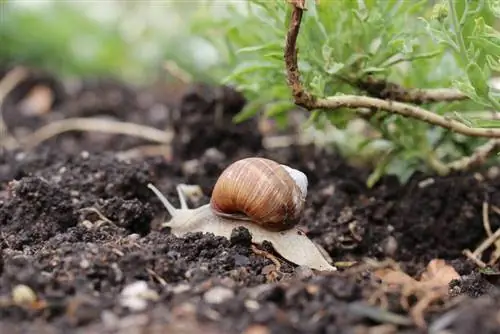
The hibernation of snails is usually only interrupted when it is disturbed. Loud noises and the touching of the snail shell or its body by people or other animals are examples that can cause a snail to wake up from hibernation at short notice. Here the body temperature quickly rises again and more energy is used. This often costs the hibernating animals too much energy, so that their stored fat stores are not sufficient, especially in long winters, and they starve to death during the winter.
Hibernation End
Waking up mainly depends on the outside temperature, but other factors also play a role. If the metabolism begins to become more active again as temperatures rise, so-called metabolic end products are produced, which experts assume serve as a kind of wake-up signal for the snails. When the body temperature slowly rises again, hormone production is also stimulated. Certain hormones then take on the task of breaking down brown fat tissue, which acted as a thermal cushion during hibernation. When the outside temperature is around 15 degrees Celsius, muscle tremors begin automatically and the body temperature increases further.
For some species, such as the Roman snail, an outside temperature of around eight degrees Celsius is sufficient. In contrast to the slug, it is less sensitive to cold and usually wakes up from hibernation earlier.
Winter quarters
When choosing winter quarters, different species of snails prefer different places to overwinter. The snail, for example, retreats completely into its snail shell. It blocks the entrance with lime, which it can provide itself through its own secretion. This closure is intended to protect them from “intruders” and predators, as well as from too much cold exposure while they are in hibernation. However, small air holes remain in the lime cover so that gas exchange can take place even during hibernation.
They mostly stay in damp places, which also offer them privacy. These include, for example:
- In and under piles of leaves
- Buried in deeper holes in the ground
- In hollows of trees
- Under and between piles of wood
Other species of snails, such as the land snail without a snail shell, as slugs are also called, are usually limited to burrows in the ground. They dig them out until they can fit completely inside. They also pull in other plant parts and use them to pad their cave. If they are in the cave, they cover the cave entrance with earth.
Dehydration
For these small, comfortable slimy creatures, in addition to freezing to death, drying out is also a risk of death during hibernation. Since she doesn't absorb water during the winter season or when she's sleeping, she has to keep her body moist in other ways. This happens through a mucous coating that wraps itself around its body. This layer of mucus takes some time to dry completely and then acts like a cling film. However, if winter sets in quickly and there is a rapid drop in temperature, the slime layer may not dry out and the snail will dry out after just a few days.
External hazards
While the only predator of Roman snails is humans, other species of snails, such as the slug, are exposed to several enemies in the winter. Land snails without snail shell protection are particularly at risk.

Their mucus, which coats the body and is produced when threatened, as well as the reaction of the blood, which makes the snail's body hard and resilient, is not possible during hibernation. Although they contract and the body becomes a little harder, the reduced energy requirement means that a permanent state cannot be achieved.
Although most slugs taste terrible, the limited food supply in winter forces some animals to eat these specimens too. These include, for example, martens or chickens.
Snail control
Although they are not unimportant for the natural ecosystem, slugs in particular annoy many hobby gardeners. For these, late autumn and winter are the optimal time to get rid of annoying plant pests when cold temperatures have caused them to fall into hibernation.
You should take the following steps to find as many hibernating snails as possible so that you can then dispose of them or release them elsewhere:
- Digging vegetable beds
- Deep digging through soil around trees and bushes
- Enclose stored stacks of wood with smooth plastic planks on the floor about five centimeters high
- Removing piles of leaves
- In early autumn, water plants little or not at all to avoid constant moisture
Also keep an eye out for any eggs, as slugs in particular bury them about ten centimeters deep into the ground to protect them from the frost. In the spring you will have lots of little young snails in your garden if you haven't already found and uncovered them in the fall. The eggs freeze on the surface of the earth. Here it is sometimes enough to turn over the soil once so that the eggs are laid upwards from the depths and are thus exposed to the frost.
Tip:
In order to fundamentally prevent snails from entering your home garden to overwinter, it is recommended to put a special snail fence around the property at the beginning of October. However, this should be dismantled at the beginning of March at the latest so that the plant pests can get out again if they are looking for food and cannot find enough in your garden.
Conclusion
As a rule, the various species of snails hibernate, although some can also endure freezing temperatures by falling into hibernation.
In winter they are very frugal and quite undemanding when it comes to their winter quarters. They can be found wherever caves, leaves, wood storage and possibly compost heaps offer them protection from predators and cold winter temperatures. Here you can easily collect them, while you should turn over the soil so that eggs reach the surface and are destroyed by the frost. But don't forget that snails, for example, are subject to nature conservation and must not be killed.

